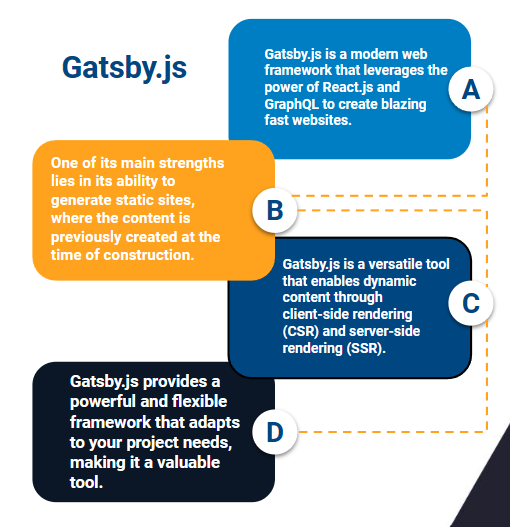.png)
Gatsby vs Next.js: choosing the right framework
January 04, 2024
Table of contents
Quick Access
In the rapidly evolving web development landscape, the choice of a front-end framework can significantly impact the success of a project. Two contenders that frequently dominate discussions are Gatsby and Next.js.
In this technical blog, we delve into the intricacies of both frameworks, exploring their architectures, key features, and use cases to help developers make an informed decision.

Gatsby or Next.js: Which one does you need?
1. Architecture
Gatsby:
Gatsby, a static site generator, pre-creates pages at compile time. It leverages React and GraphQL, enabling seamless data retrieval. The resulting static assets can be effortlessly deployed to content delivery networks (CDNs), ensuring fast page loading.
Next.js:
Next.js takes a versatile approach, supporting both server-side rendering (SSR) and static site generation. Its hybrid model makes it easy to generate dynamic content while providing the benefits of static site performance.

2. Data collection
Gatsby:
Gatsby's strength lies in its GraphQL-based data layer. Developers can obtain data from multiple providers, consolidating information seamlessly. The GraphQL schema facilitates efficient queries and provides a unified interface for data retrieval.
Next.js:
Next.js employs a server-side rendering paradigm, fetching data on the server before sending it to the client. While versatile, this approach can introduce latency in certain scenarios, especially when dealing with a large volume of dynamic content.
3. Performance
Gatsby:
With its focus on static site generation, Gatsby excels at delivering optimal performance. By offering pre-built HTML files, Gatsby sites are inherently faster, improving the user experience, especially for content-heavy websites.
Next.js:
Next.js strikes a balance between static and dynamic rendering. While static pages ensure fast initial loads, dynamic content can introduce additional processing on the server side, affecting performance, especially when traffic is high.

4. Scalability
Gatsby:
Gatsby's scalability shines in projects with predominantly static content. However, dynamic content updates may require regeneration of the entire site, which could impact the scalability of frequently changing data.
Next.js:
Next.js offers scalability for projects of varying complexity. Its ability to handle server-side rendering makes it suitable for dynamic applications, but developers must consider potential bottlenecks in complex SSR scenarios.
5. Use cases
Gatsby:
Ideal for content-focused websites, blogs, and portfolios where content updates are less frequent. Gatsby's robust static site generation excels in scenarios where performance and SEO are paramount.
Next.js:
Well suited for dynamic web applications that require server-side rendering or a combination of static and dynamic content. Ecommerce platforms, dashboards, and applications with real-time data benefit from the versatility of Next.js.
The choice between Gatsby and Next.js depends on the project requirements. Gatsby shines in scenarios that prioritize performance and static content, while Next.js provides flexibility for projects that demand dynamic content and server-side rendering.
Evaluating the nuances of each framework against the project objectives is crucial to making an informed decision. Ultimately, the choice depends on the specific needs of the project and the desired balance between performance and dynamism.
We recommend you on video
Related Blogs

Steps for software product development
-9.20.37-a.m.png)
Product Design and Development

Tools for Machine Learning

The Best Data Science Tools in 2025

What is Data Science?
